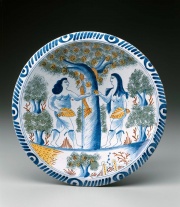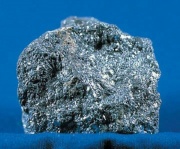Antimony
Description
A bluish-white, brittle metallic element. Antimony occurs in the ores stibnite, kermasite, tetrahedrite, livingstone, and jamisonite. It is mined in China, Mexico, Canada and Bolivia. Antimony, originally called stibium, was first described in 1450 by Tholde (Basil Valentine). As a metal, antimony is hard and shiny but neither malleable or ductile. Antimony does not tarnish in dry air and tarnishes slowly in moist air. Antimony is used in the manufacture of alloys, such as britannia metal and babbitt metal. It is also used for bullets, fireworks and as decorative metal coatings. Antimony has been found in trace amounts in ancient copper and lead alloys. Pure antimony can be found in the metallic form and in two allotropic forms, as yellow crystals and as a black powder. The black powder, as well as the orange antimony sulfide, was occasionally used as a cosmetic in Egypt from the Amarna period onwards.
Synonyms and Related Terms
Sb; stibium; antimoon (Ned.); antimoine (Fr.); Antimon (Ces., Deut., Nor., Sven.); antimonio (It., Esp.); Antimônio (Port.); antimony black; antimony regulus; CI 77050
Other Properties
Flame color is blue.
Soluble in aqua regia, nitric acid and hot concentrated sulfuric acid. Insoluble in cold, dilute acids.
Hexagonal crystal system. Fracture = uneven; brittle Cleavage = perfect in one direction. Luster = metallic. Streak = tin-white to steel-gray
| Composition | Sb (atomic no. 51) |
|---|---|
| CAS | 7440-36-0 |
| Mohs Hardness | 3.0 - 3.5 |
| Melting Point | 630.5 |
| Density | 6.62-6.68 |
| Molecular Weight | atomic wt = 121.75 |
| Boiling Point | 1635 |
Hazards and Safety
Inhalation and contact with dust and fumes can cause irritation. Antimony will react with hydrogen to form highly toxic stibine.
Combustible. Black antimony is explosive in air. Salts are highly toxic.
International Chemical Safety Card
Additional Information
° J. Ogden, "Metals" in Ancient Egyptian Materials and Technology, P.Nicholson, I.Shaw (eds.), Cambridge University Press, 2000, p. 149. ° Mineralogy Database: Antimony ° Web Elements: Website
Authority
- Richard S. Lewis, Hawley's Condensed Chemical Dictionary, Van Nostrand Reinhold, New York, 10th ed., 1993
- David C. Scott, Metallography and Microstructure of Ancient and Historic Metals, The Getty Conservation Institute, Los Angeles, 1991
- Jack Odgen, Jewellery of the Ancient World, Rizzoli International Publications Inc., New York City, 1982
- Van Nostrand's Scientific Encyclopedia, Douglas M. Considine (ed.), Van Nostrand Reinhold, New York, 1976
- The Merck Index, Martha Windholz (ed.), Merck Research Labs, Rahway NJ, 10th edition, 1983 Comment: entry #733
- Encyclopedia Britannica, http://www.britannica.com Comment: "antimony" [Accessed December 11, 2001]. (BW photo) flame = blue
- G.S.Brady, Materials Handbook, McGraw-Hill Book Co., New York, 1971 Comment: p. 63
- C.W.Chesterman, K.E.Lowe, Audubon Society Field Guide to North American Rocks and Minerals, Alfred A. Knopf, New York, 1979
- Matt Roberts, Don Etherington, Bookbinding and the Conservation of Books: a Dictionary of Descriptive Terminology, U.S. Government Printing Office, Washington DC, 1982
- Random House, Webster's Encyclopedic Unabridged Dictionary of the English Language, Grammercy Book, New York, 1997
- The American Heritage Dictionary or Encarta, via Microsoft Bookshelf 98, Microsoft Corp., 1998
- Chemical & Engineering News, American Chemical Society, Washington DC, 81 (36) , Sept. 8, 2003
- Wikipedia, the free encyclopedia, at http://www.wikipedia.com Comment: http://en.wikipedia.org/wiki/Antimony (Accessed Mar. 20, 2006)
- Susan E. Schur, Conservation Terminology: A review of Past & Current Nomenclature of Materials, Technology and Conservation, Spring (p.34-39); Summer (p.35-38); Fall (p.25-36), 1985

